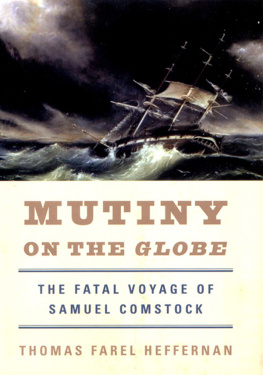
 | MUTINY
ON THE
GLOBE 
THE FATAL VOYAGE
OF SAMUEL COMSTOCK
THOMAS FAREL HEFFERNAN

W. W. NORTON & COMPANY
NEW YORK LONDON
|  |
For Frank and Win Gallagher
Thomas Worth, captain of the Globe. Courtesy, the Marthas Vineyard Historical Society
Illustrations from William Comstock, The Life of Samuel Comstock, the Terrible Whaleman
Frontispiece: The Whale Ship Globe of Nantucket. Courtesy of the Nantucket Historical Association
Title page of The Life of Samuel Comstock, the Terrible Whaleman. Courtesy of the Nantucket Historical Association
A Desperate Struggle Between Comstock and the Negro. Courtesy of the Nantucket Historical Association
Dreadful Conflict Between Chicochee and the Indian Queen. Collection of the New-York Historical Society (negative #75049)
Comstock Running Lumbert Through the Body. Courtesy of the Nantucket Historical Association
The Execution of Humphries. Courtesy of the Nantucket Historical Association
The Death of Samuel Comstock. Courtesy of the Nantucket Historical Association
Title page of Lay and Hussey, A Narrative of the Mutiny, on Board the Ship Globe, of Nantucket. Courtesy of the Nantucket Historical Association
Hiram Paulding, first lieutenant of the Dolphin. Courtesy of the Navy Art Collection, Naval Historical Center
John Percival, captain of the Dolphin. Official U.S. Navy photograph. Courtesy of the U.S. Naval Academy Museum
Manifest of the Globe. Courtesy of Renny Stackpole
Captain Josiah Macy. From Millstein Division of United States History, Local History & Genealogy, the New York Public Library, Astor, Lenox and Tilden Foundations
Mulgrave Islands (Mili Atoll) as Surveyed by the U.S. Schooner Dolphin; from Paulding, Journal of a Cruise of the United States Schooner Dolphin. From General Research Division, the New York Public Library, Astor, Lenox and Tilden Foundations
A Canoe and Natives of Mulgraves Range, from Arthur Phillip, The Voyage of Governor Phillip to Botany Bay with Contributions by Other Officers of the First Fleet and Observations on Affairs of the Time by Lord Auckland. From General Research Division, the New York Public Library, Astor, Lenox and Tilden Foundations
View of South Street from Maiden Lane (1828). By William James Bennett. All rights reserved, the Metropolitan Museum of Art, Bequest of Edward W. C. Arnold, 1954. The Edward W. C. Arnold Collection of New York Prints, Maps and Pictures (54.90.130)

pp. 8687 Mili Atoll and the World of the Globe, endpapers. Map by John McAusland
p. 98 Rendering of a map attributed to George Comstock showing Samuel Comstocks last movements. Courtesy of the Nantucket Historical Association. Rendering by John McAusland
pp. 23940 Two pages of the Marshallese glossary from the first edition of Lay and Hussey, A Narrative of the Mutiny, on Board the Ship Globe, of Nantucket. Courtesy of the Nantucket Historical Association
I n two long back-slashes the Ralik and Ratak chains of the Marshall Islands slope across the Pacific halfway between Hawaii and Papua New Guinea, directly north of New Zealand. At the top of the western or Ralik chain stands Bikini Atoll, where the sky once sprouted atomic mushrooms from nuclear tests and where today divers on pricey excursions swim like tropical fish around the sunken hulks of the test targets, the aircraft carrier Saratoga and the battleship Arkansas. Here, in the 1970s, the natives, evacuated by the government since the days of the testing, were officially reassured that their homes were safe and were allowed to return and to eat food grown in the cesium-laden soil, only to be evacuated once again.
Diagonally across the Marshalls from Bikini, at the bottom of the Ratak chain, lies Mili Atoll, whose eight hundred people live mainly on the harvest of copra, dried coconut meat. Air Marshall Islands flies in and out of the atoll, landing on a hillside lawn cut through a grove of coconut trees. The islands of Mili Atoll are in the running for recognition as the site of Amelia Earharts forced landing.
On February 10, 1824, a Nantucket whaleship sailed northwest from the Gilbert Islands toward Mili and came even with the atolls little southeastern spur known as Knox Island, at the tip of which lies the island of Nako. Nako is, in Marshallese lore, the place where all the dead of the world either reside or ascend to the next life. It was fortunate for the more superstitious members of the ships crew that they did not know that, for they would have feared coming close enough to the eerie island to meet the bloody wraiths of their captain and their first, second, and third matesand the reunion would not have been a happy one.
The ship was the Globe, a whaler of some distinction. On one previous voyage it became the first whaleship to return more than two thousand barrels of oil, and on another it discovered the celebrated Off-Shore Ground west of northern Peru, one of the richest whaling grounds in the world. But two weeks before it sailed toward Mili, it had achieved its crowning distinction: it was the stage of the bloodiest mutiny in the history of American whaling. And not merely bloody, but strange. The murder of all the officers of the ship was the stark and ghastly fact and was all done in a matter of minutes. But why was it done? Not for any reasons that would have made sense in the whale fishery up until the Globes fatal day. What went before the mutiny and what came after it make a tale of violence, mad caprice, survival, and wild chance.
Nantucketers, from the time when whaling began on their island in the seventeenth century, watched their fisheries expand as if whaling grounds were liquids poured out and spreading over a map of the world. Whaling voyages lengthened to more than three years as the tonnage of the ships increased. The crew lists from captain to cooper contained names that had been whaling names for generationsnames like Starbuck and Howland and Gardner that are still to be found next to small islands on maps of the Pacific. Pushed to the kind of risk and toil that war requires, the Nantucket whaleman was exactly what Moby-Dick makes him out to be: he was Bulkington, who needed the fatal sea more than he needed the safe land; he was Starbuck, the devout Quaker; and Flask, drunk on adrenaline. And was there an Ahab among the Nantucket whalemensomeone who went to sea out of impulses so at odds with the spoken and unspoken morality of his little island that no one there would have conceived of such a soul?
The following is a story of one man so led by fantastic impulses as to be creatively vicious and so immune to the promptings of conscience as to need a universe of which he would be the sole occupant. It is also the story of a cowed and confused crew, marooned seamen turned native and surviving by wits and luck, naval heroes, prostitution riots and offended Hawaiian missionaries, and six men making a nearly impossible crossing of the Pacific in a disabled ship.
Next page













